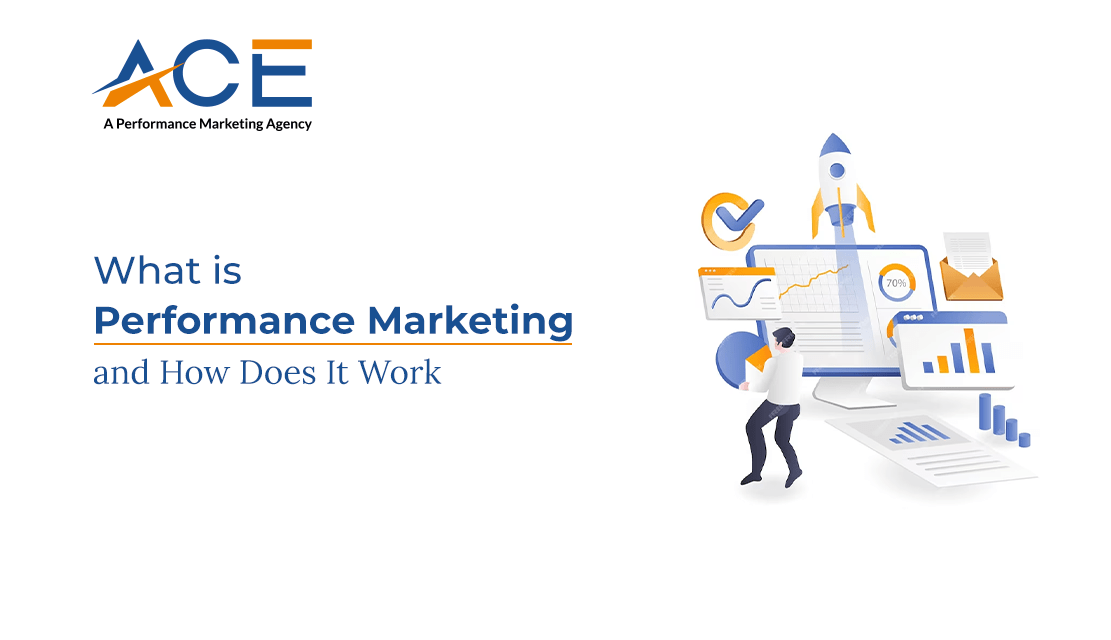In today’s fast-paced digital landscape, businesses are constantly seeking innovative ways to promote their products and services effectively.
The world of digital marketing is HUGE, with a multitude of different strategies and approaches to engaging potential customers. Among these strategies, one that often goes under the radar yet has a significant impact is performance marketing.
In this blog, we will take a deeper look at the incredible potential of performance marketing, discussing how it works, why it is essential and the numerous advantages it offers businesses.
Let’s crack the code of performance marketing together.
What Does Performance Marketing Mean?
So What Does Performance Marketing Mean?
Performance marketing in digital marketing is one of the most dynamic and result-driven strategies. Unlike traditional advertising methods where you pay upfront and hope for the best, performance marketing is a method of advertising that focuses on achieving your business goals. Advertisers only pay when specific actions are taken, such as clicks, sales or leads. Essentially, it is a form of digital marketing where your budget is put to work based on the interactions your content has with your targeted customers.
Performance marketing involves a partnership between brands and marketing service providers, such as agencies or publishers.
Advertisers collaborate with these partners to design and place advertisements across various performance marketing channels, which can include social media, search engines, videos, embedded web content and more.
With APM as your performance marketing company, you are not paying a fixed fee for advertising, payments are based on performance metrics such as clicks, impressions, shared content, sales, etc.
How Performance Marketing Works
The key to understanding how performance marketing works is to understand the payment models it relies on in order to gain a deeper understanding.
Here are the primary payment structures in performance marketing:
Cost Per Click (CPC):
CPC is a popular payment model when it comes to performance marketing. This model simplifies payment to a straightforward concept: advertisers pay each time a user clicks on their ad. This method serves as an extremely effective way to drive traffic to your website. You only invest when potential customers actively engage with your content, ensuring that your budget is spent where it matters most.
Cost Per Impression (CPM):
CPM takes a slightly different route than CPC. Here, advertisers pay for every thousand times their ad is displayed or “impressed.” It is an excellent choice when your primary goal is to boost brand awareness. With CPM, you are able to reach a huge number of people, making sure your brand is exposed to the largest possible audience. Each impression contributes to brand visibility, making it particularly valuable for businesses looking to enhance their online presence.
Cost Per Sale (CPS):
The CPS model follows a performance marketing principle that resonates with affiliate marketing. Advertisers only submit a payment when their ad leads directly to a sale. This precise payment structure ensures that your budget is allocated solely to actions that drive revenue. It is a win-win situation, as advertisers see a clear return on investment, and affiliates receive compensation for their contribution to the sale.
Cost Per Lead (CPL):
Similar to CPS, CPL draws attention to a specific user action. In this case, advertisers pay when a user signs up for a service like an email newsletter or a webinar. The reason this is valuable is that CPL generates leads, users who express genuine interest in what you have to offer. These leads are potential customers, making CPL an effective method of building your customer base and nurturing relationships.
Cost Per Acquisition (CPA):
CPA takes a more inclusive approach by considering a broader range of user actions. Advertisers pay when users take specific actions, which might include making a purchase, sharing contact information or even simply visiting a blog. This versatility allows for a more accurate measurement of performance, as you are only investing when valuable interactions occur. CPA provides the flexibility needed to cater to various campaign goals and objectives.
Top Performance Marketing Channels
Performance marketing isn’t limited to a few channels, it can be applied across a range of media platforms, which is why it thrives.
Here are some of the top performance marketing channels that agencies and advertisers leverage:
Banner (Display) Ads:
You have most likely encountered display ads on social media or websites. While ad blockers and banner blindness have become concerns, engaging content, videos and creative design can still yield results.
Native Advertising:
Native ads blend seamlessly with a web page’s content, making them appear natural and less disruptive. They can be found on platforms like YouTube or Facebook Marketplace.
Content Marketing:
A cost-effective way to educate and engage your audience, content marketing provides useful information, such as blog posts, case studies and e-books, often linked to your products or services.
Social Media:
Social media platforms offer a haven for performance marketers. They not only enable you to reach users but also allow for organic sharing of sponsored content, extending your brand’s reach.
Search Engine Marketing (SEM):
For effective performance marketing, having a website optimized for search engines is crucial. It predominantly focuses on cost-per-click (CPC), for paid advertising and leverages content marketing for organic search engine optimization.
Performance Marketing Types
Performance marketing is versatile and adaptable, making it applicable to a variety of advertising strategies.
Here are some common examples for different performance marketing types:
Pay-Per-Click (PPC) Advertising:
Pay-Per-Click advertising is like a guided tour of your website, where advertisers pay for each visitor brought by a click. Google AdWords, a prominent platform, offers this service. When a user clicks on your ad, it directs them to your online store. Advertisers invest in these clicks, ensuring that their budget is used effectively to attract potential customers that are actively engaging with their content. This method is a driving force behind website traffic and a key component of performance marketing in digital marketing.
Affiliate Marketing:
Affiliate marketing operates as a symbiotic partnership between businesses and affiliates who promote their products or services. They act as digital messengers, driving traffic and sales through their marketing efforts, often utilizing blogs and social media platforms. Businesses reward affiliates based on their ability to generate sales. It is a collaborative approach that leverages reach and influence to extend a brand’s footprint, making it an essential strategy for performance marketing.
Email Marketing:
Email marketing is a versatile strategy that falls under the category of performance marketing. While not always associated with performance marketing, email campaigns can be performance-driven. Marketers carefully examine metrics like open rates, click-through rates and conversion rates to optimize their campaigns.
Search Engine Optimization (SEO):
Search Engine Optimization (SEO) is the backbone of performance marketing, even though it is not a paid strategy. SEO focuses on optimizing your online presence to improve your ranking in search engines. SEO success is measured by various factors, including keyword rankings, organic traffic, bounce rates and more. SEO ensures that your users find your website when they need you.
Social Media Advertising:
With social media dominating, businesses use platforms like Facebook, Instagram, Twitter and LinkedIn to reach their target audience. They offer precision targeting options, allowing advertisers to reach the right users at the right time. Performance in social media advertising is tracked through metrics like engagements, clicks, impressions and conversion rates.
Influencer Marketing:
Influencer marketing is where brands partner with influencers with their followers to promote products or services. Influencers act as digital megaphones, and performance in influencer marketing is measured through engagements, impressions, clicks and sales generated through unique promo codes or affiliate links.
Display Advertising:
In display advertising, advertisers pay for banner ads to be displayed on websites relevant to their product or service. Payment models include CPM (Cost Per Mille), CPC (Cost Per Click) or CPA (Cost Per Acquisition). Display advertising is a performance marketing channel that blends exposure with precise metrics to ensure budget efficiency.
Content Marketing:
Content marketing involves creating and sharing informative content, such as blog posts and case studies, to attract and convert prospects into customers. Performance in content marketing is often measured by engagement rates, social shares and lead generation. Nurturing relationships and driving value are at the heart of content marketing.
Performance Marketing Benefits
Let’s talk about why performance marketing is important. Performance marketing services offer a number of advantages that can help businesses thrive online.
Let’s explore why this strategy is crucial for modern businesses:
Cost-Efficiency:
In performance marketing, every penny counts. Advertisers only part with their budgets when specific actions, like clicks or conversions, occur. This eliminates wasteful spending, ensuring that your resources are channeled precisely where they matter most. It reduces financial leakage and maaximizes the efficiency of your marketing budget.
Measurable Results:
The performance marketing landscape is characterized by a data-driven approach. It provides you with trackable data, like clicks, impressions and conversion rates, enabling you to measure your campaign’s success with precision. This real-time feedback empowers you to optimize your strategies in real time, ensuring that you are always on the right track.
Targeting Capabilities:
Performance marketing provides a pretty accurate level of precision when it comes to targeting. This strategy leverages digital platforms with laser-focused targeting options, allowing your message to reach the right audience at the right time.
Risk Reduction:
When it comes to traditional advertising, costs are incurred regardless of outcomes. But in performance marketing, it is a different story. Payments are tied to specific actions, reducing financial risks. This direct correlation between investment and results minimizes uncertainty.
Brand Exposure:
Performance marketing campaigns aren’t just about numbers – they are also about nurturing your brand in a positive way. By strategically reaching your audience across various channels, these campaigns enhance your brand’s visibility. Over time, this consistent exposure contributes to brand recognition and trust. This lets your presence be felt and establishes a sense of trustworthiness.
Scalability:
Starting small and dreaming big is the mantra of performance marketing. It allows businesses to initiate campaigns on a modest scale and then scale up when success arrives, maximizing your return on investment. Performance marketing’s scalability is your greatest asset in the world of digital marketing.
Performance marketing services are especially valuable for businesses with limited marketing budgets that need to make the most of every penny. It allows for rapid business growth and offers nearly immediate results.
Developing a Performance Marketing Strategy
Now that we know why performance marketing is important, it is time to discuss how to develop a winning strategy. While performance marketing benefits are evident, a successful campaign requires careful planning and execution.
Here’s how to develop a strong performance marketing strategy:
1. Decide on Your Campaign Message:
Define the specific message you want to convey to your target audience. Determine the call-to-action you want users to take, whether it is requesting a demo or exploring a new product.
2. Plan Your Brand Positioning:
Establish how your brand relates to your campaign message and what unique value you offer. Connect your brand’s message to the campaign’s context to create a compelling narrative.
3. Create Performance Targets:
Set clear goals and key performance indicators (KPIs) to measure your campaign’s success. KPIs may vary based on your campaign’s objectives, such as generating leads or reducing customer acquisition costs.
4. Know Your Channel Mix:
Allocate your marketing budget across different channels, such as paid search, paid social or connected TV advertising. Determine the allocation for each channel.
5. Get Your Website Ready:
Ensure that your website is prepared to convert users who interact with your ads. Consider creating landing pages, optimizing the user experience and aligning your website’s content with your campaign message.
6. Create and Launch the Campaign:
Select your target audience, input campaign details and upload creative content. Launch your campaign on your chosen advertising channels.
7. Measure and Optimize Along the Way:
Continuously monitor your campaign’s performance and adjust it as needed to achieve your KPIs. Implement A/B testing, modify your target audience or refine your ad content to improve performance.
Conclusion
In conclusion, performance marketing is a powerful and cost-effective strategy that empowers businesses to maximize their advertising efforts while minimizing risks. By carefully planning and executing a performance marketing strategy, businesses can achieve their objectives, reach their target audience and drive measurable results in the dynamic world of performance marketing in digital marketing. Performance marketing agencies like APM, help your performance marketing efforts take your business to the next level.




